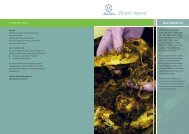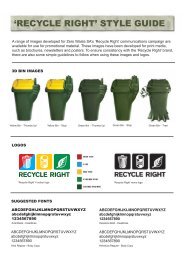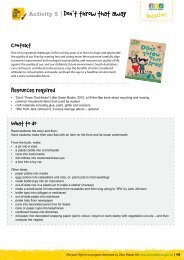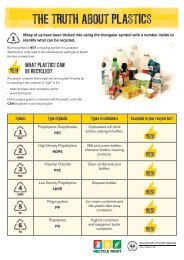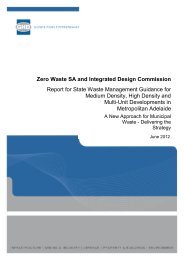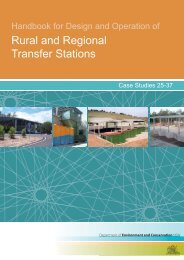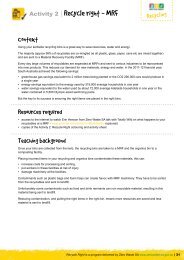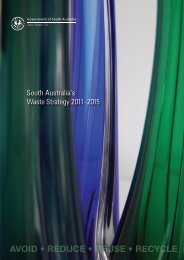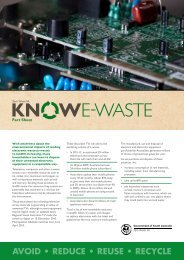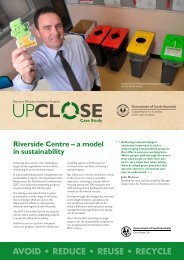Annual Report 2010-11 - Zero Waste SA - SA.Gov.au
Annual Report 2010-11 - Zero Waste SA - SA.Gov.au
Annual Report 2010-11 - Zero Waste SA - SA.Gov.au
You also want an ePaper? Increase the reach of your titles
YUMPU automatically turns print PDFs into web optimized ePapers that Google loves.
30<br />
The aluminium and mercury will be used to make new<br />
light globes, the phosphor powder into fertiliser, and the<br />
glass will be re-used into a variety of other glass products.<br />
Household and Farm Chemical Collection mobile collections<br />
In <strong>2010</strong>–<strong>11</strong>, the mobile collection program collected 89.5<br />
tonnes of household hazardous waste and farm chemicals<br />
from more than 1,800 members of the public in four<br />
regional and six metropolitan council collections.<br />
Number of<br />
vehicles<br />
Total weight<br />
(kg)<br />
Country collections<br />
Port Pirie Regional<br />
55 3,014<br />
Council (two collections)<br />
Mid Murray 3 279<br />
Rural City of Murray<br />
20 3,673<br />
Bridge<br />
Metropolitan collections<br />
Adelaide City Council 85 3,246<br />
Norwood, Payneham and<br />
319 9942.5<br />
St Peters, Walkerville,<br />
Campbelltown and<br />
Burnside councils<br />
City of Onkaparinga<br />
899 43,974<br />
(two collections)<br />
Adelaide Hills Council 220 9,491<br />
Town of Gawler, the City<br />
264 15,898<br />
of Playford and City of<br />
Salisbury<br />
TOTAL 1,865 89,518<br />
Details of collections can be found at: www.zerowaste.<br />
sa.gov.<strong>au</strong>/at-home/hazardous-waste/household-hazardouswaste-collection-timetables.<br />
Light globe recycling program<br />
On 18 January 20<strong>11</strong>, <strong>Zero</strong> <strong>Waste</strong> <strong>SA</strong> l<strong>au</strong>nched a three-year<br />
pilot program – the BackLight Household Light Globe<br />
Recycling Program. Householders can now drop off a<br />
range of used fluorescent light globes for recycling at<br />
24 metropolitan and 26 regional Mitre 10 stores across<br />
the State, free of charge. The globes are then recycled by<br />
Chemsal Resource Recovery. The aluminium and mercury<br />
will be used to make new light globes, the phosphor<br />
powder into fertiliser, and the glass will be re-used into a<br />
variety of other glass products.<br />
After six months, the program has collected more than<br />
12,000 lamps and globes from householders for recycling,<br />
equating to a total of 1,266 kilograms.<br />
The BackLight program supports a number of State and<br />
Federal <strong>Gov</strong>ernment initiatives including:<br />
> the State <strong>Gov</strong>ernment’s commitment of directing<br />
$100,000 towards a householder ‘take back’ scheme<br />
for used globes with retailers.<br />
> the Environment Protection (<strong>Waste</strong> to Resources)<br />
Policy <strong>2010</strong> which will ban fluorescent and other<br />
mercury containing lighting from landfill, from<br />
September 2012 in metropolitan Adelaide, and<br />
September 2013 for the rest of the State by ensuring<br />
the safe disposal of the mercury contained in energy<br />
efficient light globes<br />
> the Australian <strong>Gov</strong>ernment’s ban on the retail sale of<br />
incandescent light bulbs from November 2009<br />
> the Australian <strong>Gov</strong>ernment’s voluntary Fluoro-Cycle<br />
scheme that aims to recycle the majority of commercial<br />
mercury-containing lighting.<br />
In the period <strong>2010</strong>–<strong>11</strong>, <strong>Zero</strong> <strong>Waste</strong> <strong>SA</strong> collected a total of<br />
174,035 kilograms of hazardous waste from 3,382 people.



